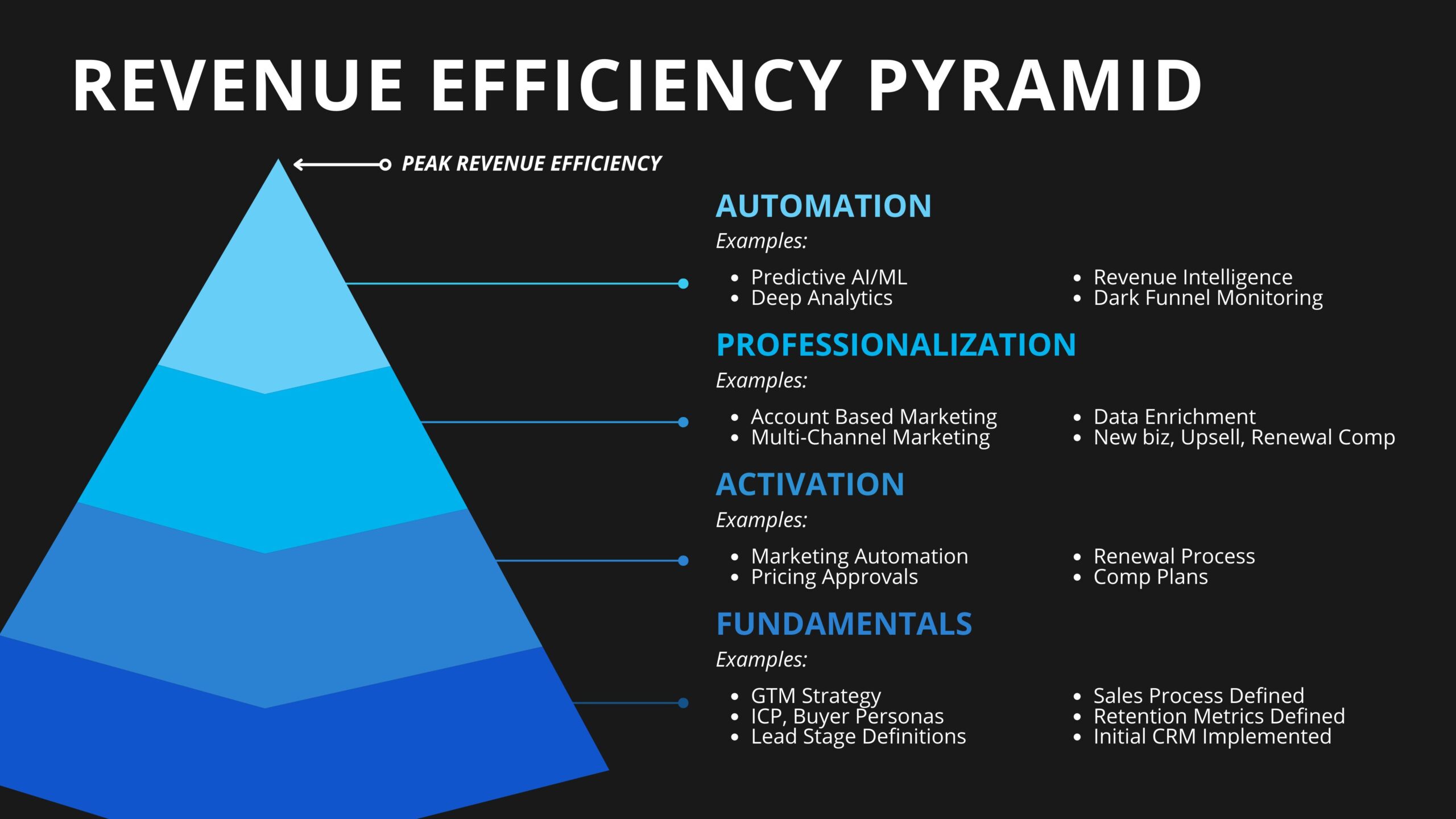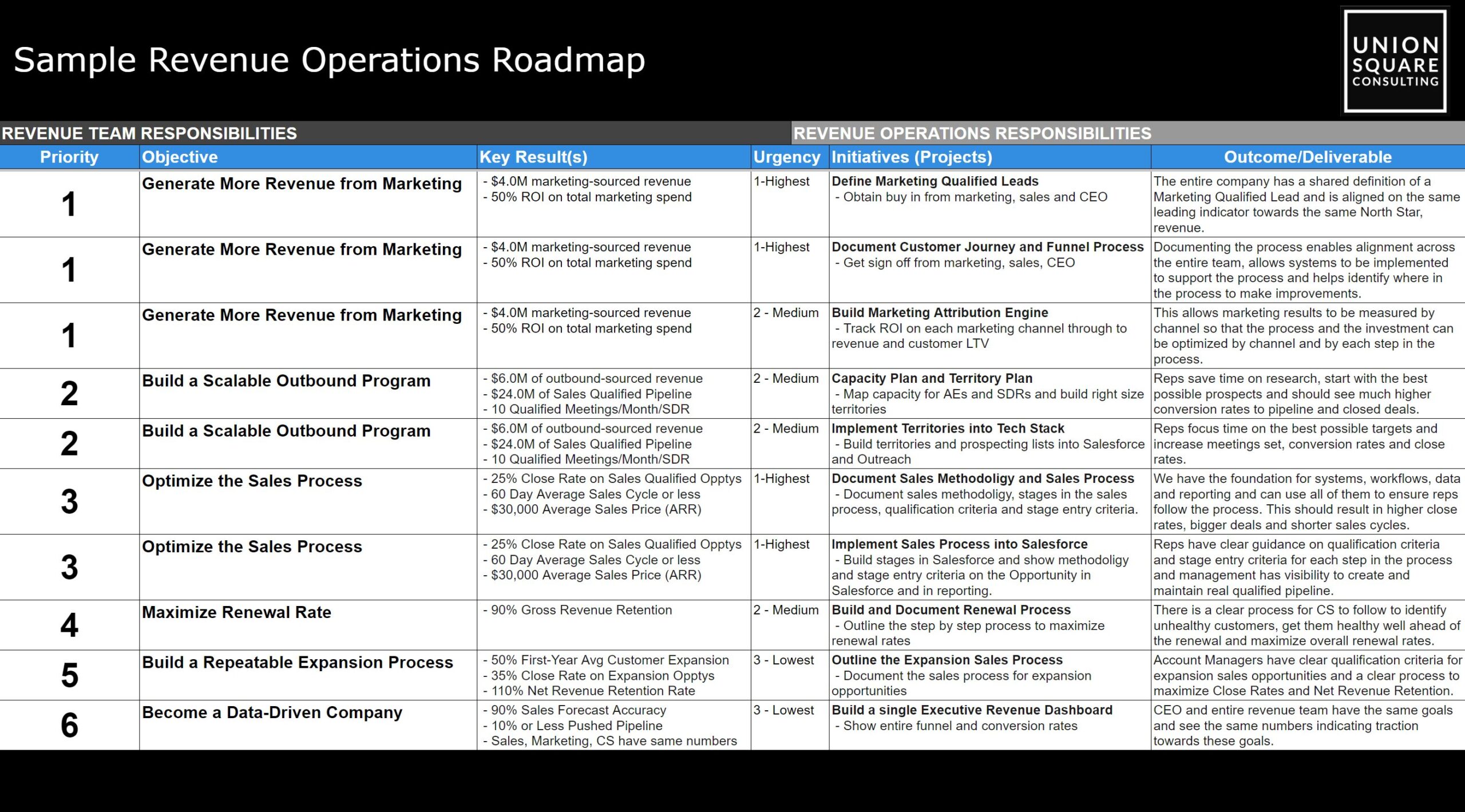
Stop the Fire Drills With a RevOps Roadmap
Read time: 9 minutesAs a revenue leader, you’re being inundated with all kinds of requests coming from every direction. Without some sort of long-term plan to guide your organization, it’s almost impossible to prioritize and say “no” to things.
And since you have people coming from different points of view asking you for different things,
the amalgamation of all those requests will not be coherent.
You end up taking Marketing, Sales and Tech in different directions that don’t line up, creating a mess you have to unwind later on.
It’s a massive pain. It prevents you from being a strategic function. It makes everything a fire drill.
That’s why you need a RevOps roadmap.
We’re going to show you exactly how we build roadmaps for our clients. But first…
What is a RevOps Roadmap?
A RevOps roadmap is a list of projects, initiatives, or technologies that, by methodically working on them, elevate the organization as a whole.
The roadmap is not used for:
- Ad hoc requests
- Non-strategic initiatives
- Or regular business practices
Your roadmap answers these questions:
- What do you want this department to become?
- And what are the things that need to be in place to get you there?
Here is an example of a RevOps Roadmap, with the Grand Plans (ie, Objectives) listed out alongside the individual projects that will actualize them.
To get your own editable copy of the full-size version, click here. Common sense rules apply: do not sell, re-brand, or otherwise try to claim this work as your own. 😉
There Must Be an Order to the Things You Want to Accomplish
Here’s the hard part: If you look at all of the things you want to accomplish in your company, you’ll be overwhelmed with an unlimited number.
It’s difficult to prioritize them and to intuitively grasp what has to happen before the other things can happen.
You need to take a fundamentals-forward approach. With the end goal of one project or initiative in mind, what needs to be done first in order for that to happen? Your roadmap cannot be built until you’ve reverse-engineered the steps back to the most fundamental starting point.
For example, if my end goal is to have a commissions automation tool in place, I might have a roadmap of three items:
- Get my comp plan in order
- Make it trackable in Salesforce
- Source a vendor for the software
Building Your Roadmap
Step 1: What Are Your Grand Plans?
First, you’ll need to decide on the Grand Plans you want to work toward (also called “Epics” in scrum and agile processes).
Note that there should be significant alignment between things like OKRs and your “Grand Plans”. For the purpose of this newsletter we won’t go into OKRs nor MBOs nor any particular management technique (you can find some resources here to learn more).
Try to align it with your business goals at a strategic level and work down from there. Ask yourself what projects/initiatives will be needed in order for you and your team to hit your objectives.
Examples of Grand Plans could be:
- We want to automate XYZ
- We want improved forecasting
- We want to improve renewal pipeline visibility
Examples of things that are not Grand Plans would be:
- We want to sell more
- We want to grow by X% by Y date
- We want to knock out all of our daily tasks
Your Grand Plan is about building a machine. What kind of work do you need to put into the machine? What does your machine look like at the end of day? And what are its components?
Ideally, you won’t be coming up with this stuff on your own and running with it. You’ll be working with a team, talking through these ideas with your CRO or CEO, and getting feedback on the order of priority.
Once you lock in the big, grandiose ideas to work on over the next 6, 12, 18 months (or however long you decide), the next step is to break them down into digestible component pieces.
Step 2: Creating Jobs From User Stories
We talked about user stories in last week’s newsletter, Breakdown of a Strategy Driven Tech Stack, and the same principle is used here.
User story formats are great tools for figuring out what jobs need to be done in order to achieve your Grand Plan. Remember that you’re wanting to reverse-engineer these steps down to their most fundamental parts, so one user story may need to be broken down into more user stories.
The general format of a user story will look like this:
“As a [functional role], I would like to be able to [capability], so that I or the business can [benefit or end result].”
So let’s say one of our Grand Plans is to automate the commissions process.
Our user stories might look like this:
“As a revenue leader, I would like to find a vendor that provides commissions automation tools so that I can automate the commissions process.”
But will that tool have the right information being fed to it? Let’s go back a step.
“As a salesperson, I would like to be able to track the information needed to calculate my commissions in Salesforce, so that the business can automate the commissions process.”
But do your salespeople know what that information is? Let’s get even more basic.
“As a sales manager, I would like to design a consistent commissions structure so that my salespeople know how they are earning commissions.”
Now, we’ve broken our Grand Plan into three jobs:
- Design a consistent commissions structure
- Set up Salesforce to track commissions information
- Find a vendor that provides commissions automation tools
The complexity of your roadmap and the number of jobs to be done will depend on your Grand Plans and the fundamentals you already have in place.
At Union Square Consulting, we use our proprietary Revenue Efficiency Pyramid as a comprehensive model for reverse-engineering Grand Plans and filling in the gaps from the fundamentals onward.
While an explanation of how we do this would be beyond the scope of this newsletter, we offer free, private Revenue Efficiency Workshops to show you how it would work for your business. Click here to see if you’re a fit.
Step 3: Get Stakeholder Approval
Before you can implement your roadmap, you’ll need to sit down with your stakeholders and present what you have so far.
- Here are the Grand Plans we agreed on
- Here are the jobs that need to happen to get there, in order
The importance of this is more than just getting approval. You need someone who’s going to back you up when you want to say “no” to all of the random ad hoc fire drill stuff.
In order to get that, you need to go above yourself and get that person’s buy-in, so they can give you air cover.
Otherwise, you’ll get peppered with stuff all day, every day (as you do), expected to turn it around as a priority, and you won’t be able to say “No, I have these other priorities set out that I need to focus on.”
Instead, if you can say, “These are the priorities of the CEO (or CRO), and I’m going to do them in order, and I’ll get to your thing later,” your world becomes instantly easier to manage.
You’ll be surprised at how fast those emergency ad hoc requests get cut in half.
Step 4: Organize, Prioritize, Implement
At this point in your organization you should have a system to organize all of the different requests you’re getting. You should be able to see the things you’re being asked for, who requested it, the due date, and the urgency level.
Once your roadmap is approved, you have to take the jobs from step 2 and compare them against the ad hoc requests.
Weave in your roadmap initiatives with the ad hoc requests, triaging urgent items with your roadmap due dates. You should always be working on the most high priority tasks.
If there’s a disagreement on priorities, take it to your boss (who already agreed on the roadmap) and get feedback on whether you have the right order going.
You’ll need to be constantly re-prioritizing as things come up, so establish a clear communication channel between your stakeholders and the people coming to you with requests.
The key is being able to say “no,” and being able to explain why.
Need Help With Your RevOps Roadmap?
That’s what we’re here for!
Aside from our Strategic RevOps Services, we also offer Weekly RevOps Coaching that provides professional development and consulting for strategic RevOps. Like having an advisor, mentor, and RevOps therapist every week.
- Learn more about Weekly RevOps Coaching
- Learn more about our Strategic RevOps Packages
TL;DR
- A RevOps roadmap answers the questions:
- What do you want this department to become?
- And what are the things that need to be in place to get you there?
- The roadmap is not used for:
- Ad hoc requests
- Non-strategic initiatives
- Or regular business practices
- Step 1: Decide on the Grand Plans you have for your organization
- Eg, We want to automate XYZ
- Eg, We want improved forecasting
- Eg, We want to improve renewal pipeline visibility
- Work with a team and talk it through with your CEO/CRO
- Step 2: Reverse-engineer the jobs to be done
- Break down everything that needs to happen under the Grand Plan
- Get down to the most fundamental step possible
- Step 3: Get stakeholder approval
- Step 4: Implement these jobs while prioritizing against ad hoc requests
When you’re ready, here’s how we can help:
Get a Free 1:1 Revenue Efficiency Workshop
Get one of our Senior Revenue Strategists to yourself for 1 hour and leave with a plan to increase the money-making power of your go-to-market operations.
Hire Us!
Bring us on as your Strategic RevOps Team and realize the growth potential of your revenue engine. There are 3 ways to work with us.
Get more tips like these, sent right to your inbox.
Subscribe for fresh, relevant revenue growth tips delivered every week.
